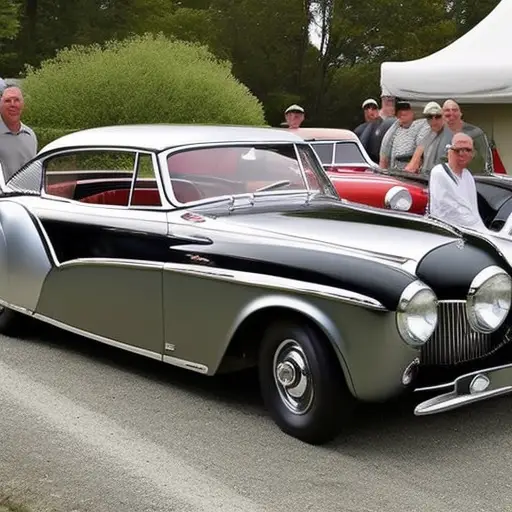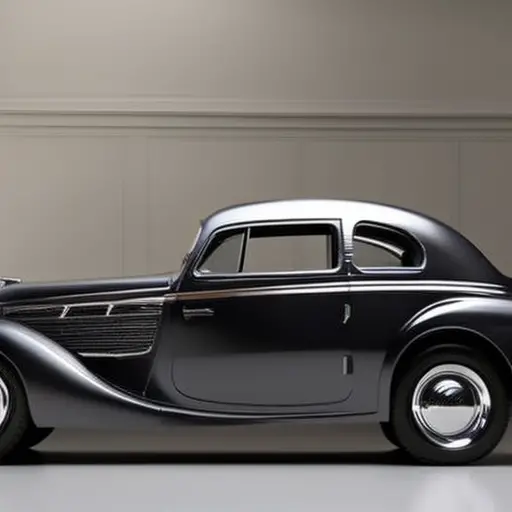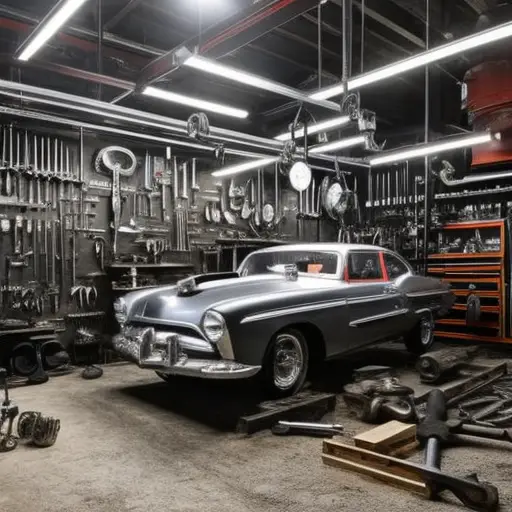How to Maintain the Value of Restored Vintage Cars

Like a time capsule of automotive history, restored vintage cars embody the artistry and craftsmanship of a bygone era. Preserving their value requires a meticulous blend of passion and precision.
From the gleaming exteriors to the lovingly maintained interiors, every detail must be carefully tended to.
In this article, we will explore the essential maintenance practices and preservation techniques that will ensure the enduring value of these automotive masterpieces.
Regular Maintenance Practices
Regular maintenance practices for restored vintage cars involve scheduled inspections and servicing to ensure the vehicle’s optimal performance and longevity. When it comes to paint protection, regular waxing and polishing are essential to safeguard the exterior from environmental elements and maintain its glossy finish. Additionally, investing in a high-quality car cover can provide an extra layer of protection, particularly if the vehicle is stored in a garage with other items that could potentially scratch the surface.
Engine tuning is another critical aspect of maintenance for vintage cars. Ensuring that the engine is in top condition not only enhances performance but also prolongs its lifespan. This involves regular oil changes, spark plug replacements, and tuning the carburetor or fuel injection system to maintain the engine’s efficiency and power.
Moreover, regular inspections of the cooling and electrical systems, brakes, and suspension components are vital to address any issues promptly and prevent further damage. By adhering to a comprehensive maintenance schedule that includes these practices, vintage car owners can preserve the vehicle’s value and enjoy its performance for years to come.
Proper Storage Techniques
Proper storage techniques are crucial for preserving the value of restored vintage cars.
Climate-controlled storage spaces protect against extreme temperatures and humidity, preventing rust and corrosion that can significantly diminish the car’s value.
Regular maintenance checks during storage also ensure that any potential issues are addressed promptly, preserving the car’s pristine condition.
Climate-Controlled Storage Spaces
Effective preservation of restored vintage cars relies heavily on the utilization of climate-controlled storage spaces. Temperature control and humidity regulation are crucial factors in maintaining the condition of these cherished vehicles.
Fluctuations in temperature can lead to the expansion and contraction of metal, potentially causing damage to the car’s body and internal components. High levels of humidity can result in corrosion and mold growth, while excessively dry conditions may lead to brittle rubber and cracked upholstery.
Climate-controlled storage spaces provide a stable environment, ensuring that the vintage car is shielded from these detrimental effects. By maintaining a consistent temperature and controlling humidity levels, these storage spaces safeguard the integrity of the vehicle’s materials, finishes, and mechanical systems, thereby preserving its value and historical significance for years to come.
Preventing Rust and Corrosion
To prevent rust and corrosion in vintage cars, it is essential to employ proper storage techniques, building upon the necessity of climate-controlled storage spaces mentioned earlier.
Proper storage is crucial for rust prevention techniques and corrosion control, ensuring the longevity of car restoration and vintage car preservation. Here are some key storage techniques to prevent rust and corrosion:
-
Dry Environment: Store the vintage car in a dry environment to prevent moisture buildup, a common cause of rust and corrosion.
-
Ventilation: Ensure proper ventilation to prevent condensation, which can lead to rust formation.
-
Covering: Use a breathable, cotton car cover to protect the vintage car from dust and debris while allowing airflow.
-
Regular Checks: Inspect the car regularly for any signs of rust or corrosion and address them promptly to prevent further damage.
Implementing these storage techniques will help maintain the value of restored vintage cars.
Regular Maintenance Checks
Regularly conducting maintenance checks is essential for preserving the value of restored vintage cars. Proper storage techniques play a crucial role in maintaining the pristine condition of these classic vehicles.
When it comes to paint care, storing the vintage car in a clean, dry garage with a controlled temperature helps prevent fading, peeling, and other paint damage. It’s also important to cover the car with a breathable, soft cloth to protect it from dust and scratches.
Engine maintenance is equally vital, and it includes regular oil changes, lubrication of moving parts, and checking for any signs of leaks or corrosion.
Exterior Care and Protection
Ensuring proper exterior care and protection is essential for maintaining the value of restored vintage cars. The exterior of a vintage car is not only a reflection of its history and craftsmanship but also a crucial factor in preserving its value. Here are some essential tips for maintaining the exterior of a restored vintage car:
-
Waxing Techniques: Regular waxing not only enhances the car’s shine but also provides a protective layer against environmental elements and UV rays. Use a high-quality carnauba wax and apply it in a circular motion for the best results.
-
Paint Protection: Invest in a quality paint sealant or ceramic coating to protect the paint from fading, oxidation, and corrosion. These products provide long-lasting protection and make it easier to clean the car’s exterior.
-
Trim and Chrome Care: Regularly clean and polish the trim and chrome parts to prevent pitting and corrosion. Use specialized products to maintain their luster and protect them from environmental damage.
-
Storage: When not in use, store the vintage car in a clean, dry garage to protect it from the elements and minimize the risk of damage.
Proper exterior care and protection not only maintain the aesthetic appeal of a vintage car but also contribute to its long-term value and desirability.
Now, let’s delve into the subsequent section about ‘interior preservation tips’.
Interior Preservation Tips
Preserving the value of a restored vintage car requires meticulous attention to both its exterior and interior, and one crucial aspect of this preservation is maintaining the pristine condition of the car’s interior. Proper interior preservation involves regular upholstery cleaning and leather conditioning. Upholstery cleaning helps in removing dirt, stains, and odors, thus preventing premature wear and tear. Meanwhile, leather conditioning keeps the leather supple, preventing it from drying out and cracking, ultimately extending its lifespan.
| Upholstery Cleaning | Leather Conditioning |
|---|---|
| Removes dirt and stains, preserving the fabric | Prevents leather from drying out and cracking |
| Eliminates odors | Keeps leather supple, extending its lifespan |
| Prevents premature wear and tear | Restores and maintains the natural shine of the leather |
Documentation and Records Management
To maintain the value of restored vintage cars, it is essential to establish and adhere to a comprehensive system for documentation and records management. This includes meticulous record-keeping and organization to ensure the preservation of the vehicle’s history and provenance. Here are some key aspects to consider:
-
Insurance Coverage: Maintain thorough documentation of all insurance policies, claims, and valuations related to the vintage car. This not only ensures that the vehicle is adequately protected but also provides future buyers with a clear understanding of its insurance history.
-
Ownership History: Document the complete ownership history of the car, including purchase receipts, titles, and any relevant transfer documents. A transparent ownership trail adds credibility and authenticity to the vehicle’s provenance, which is crucial for maintaining its value.
-
Maintenance and Restoration Records: Keep detailed records of all maintenance, repairs, and restoration work performed on the vintage car. This documentation not only validates the car’s condition but also demonstrates the care and investment put into its preservation.
-
Photographic Evidence: Capture high-quality photographs of the car throughout its restoration and maintenance journey. These images serve as valuable visual documentation, showcasing the car’s evolution and the quality of workmanship involved in its upkeep.
Professional Appraisals and Assessments
When maintaining the value of restored vintage cars, it is crucial to engage professional appraisers and assessors to accurately determine the vehicle’s current market worth. Professional appraisals and assessments are essential to ensure appraisal accuracy and to recognize the restoration quality. These experts have the knowledge and experience to thoroughly evaluate the condition, authenticity, and overall quality of the restoration work performed on vintage cars.
Professional appraisers meticulously assess various aspects of the vehicle, such as the engine, bodywork, interior, and any additional modifications or upgrades. They also consider the historical significance of the car, the rarity of its components, and its overall market demand. By engaging these professionals, vintage car owners can obtain a comprehensive and unbiased appraisal that reflects the true value of their prized possessions.
Furthermore, obtaining a professional appraisal can provide valuable documentation to support the restoration quality, originality, and any enhancements made to the vehicle. This documentation can be instrumental in proving the authenticity and historical significance of the vintage car, further solidifying its value in the eyes of potential buyers or collectors.
Frequently Asked Questions
How Often Should I Drive My Restored Vintage Car to Keep It in Good Condition?
To keep your restored vintage car in good condition, balance driving with storage solutions. Regular maintenance, such as oil changes and inspections, is crucial. Aim for occasional drives to prevent mechanical issues and ensure proper functioning.
Are There Any Specific Products or Techniques for Protecting the Paint and Body of a Restored Vintage Car?
Protecting the paint and body of a restored vintage car is crucial to maintaining its value. Utilizing protective coatings and rust prevention techniques is essential. Regular inspections, touch-ups, and professional detailing can ensure the preservation of these timeless classics.
What Should I Do if I Notice Signs of Rust or Corrosion on My Vintage Car?
When addressing signs of rust or corrosion on a vintage car, it’s crucial to employ effective rust prevention and utilize expert restoration and maintenance techniques. Timely and thorough attention to these issues ensures the preservation of the car’s value.
Can You Recommend Any Specialized Cleaning Products for the Interior of a Vintage Car?
When it comes to caring for the interior of a vintage car, specialized cleaning products play a vital role in preserving its authenticity and value. These products are especially designed to cater to the unique materials and finishes found in vintage cars. Understanding the restoration process and vintage car market trends can guide you in choosing the most suitable cleaning products to maintain the originality and appeal of your vintage car.
How Can I Ensure That the Value of My Restored Vintage Car Continues to Appreciate Over Time?
To maintain the value of a restored vintage car over time, it’s crucial to invest in comprehensive vintage car insurance and select appropriate vintage car storage options. These measures safeguard the vehicle’s condition and preserve its historical significance.
Conclusion
In conclusion, it is imperative to remember that ‘a stitch in time saves nine’ when it comes to maintaining the value of restored vintage cars.
By adhering to regular maintenance practices, proper storage techniques, exterior care and protection, interior preservation tips, documentation and records management, and seeking professional appraisals and assessments, vintage car owners can ensure that their cherished vehicles retain their value and continue to be enjoyed for years to come.




